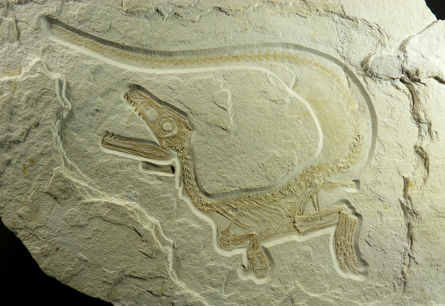Early dinosaurs probably looked a lot more like Big Bird than scientists once suspected. A newly discovered, nearly complete fossilized skeleton hints that all dinosaurs may have sported feathers.

“It suggests that the ancestor of all dinosaurs might have been a feathered animal,” says study author Mark Norell, a paleontologist at the American Museum of Natural History in New York.
Researchers have found feathered dinosaurs before, but this one is more distantly related to birds than any previously discovered. Called Sciurumimus albersdoerferi, it belongs to a group of massive dinosaurs called megalosaurs that had sharp teeth, claws and a heavy-duty frame. The specimen — a youngster that lived about 150 million years ago — is only 70 centimeters long, but it could have grown up to 10 meters, about the length of a school bus.
The fossil’s feathers aren’t the only things getting paleontologists all aflutter. The skeleton’s condition is exciting, too.
“It’s a gorgeous specimen,” says Luis Chiappe, a paleontologist at the Natural History Museum of Los Angeles County. “Probably one of the best meat-eating dinosaurs ever preserved.”
The skeleton rests in a bed of limestone, back arched, mouth gaping, tail curled behind its head. Its bones are unbroken and still carry remnants of flesh, scientists report online July 2 in the Proceedings of the National Academy of Sciences. “There aren’t many more things you can ask of a fossil,” Chiappe says.
Bits of smooth, scaleless skin anchor long, fine feathers to the tail. Unlike modern feathers, these “protofeathers” or “type 1 feathers” look like simple strands of hair. The thin, flexible feathers are ancient versions of the broad, branching plumage —“type 2 feathers” — that adorn modern birds. Though the feathers look different, both are made from the same basic ingredients.
In life, the hairlike feathers would have given the dinosaur a thick coat and a bushy tail. (Part of the dinosaur’s name, Sciurumimus, derives from the Greek for “squirrel mimic.”) “It looks like it was a pretty fluffy kind of thing,” Norell says. “Kind of like a baby chick.”
Eventually, the study’s authors hope to figure out the color of the dinosaur’s feathers. But because color tests require fossil snippets, scientists would have to clip bits from the dinosaur’s remains. And since this specimen is one of a kind, researchers aren’t quite ready to disturb it.
So far, nearly all of the feathered dinosaurs ever discovered have come from eastern Asia. But excavators unearthed this fossil in southern Germany. Even in places collectors picked over for 150 years, Norell says, new things keep turning up. “There’s always more out there,” he says.






